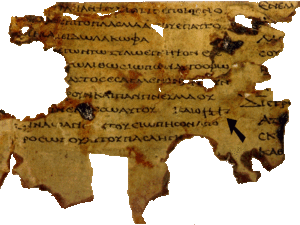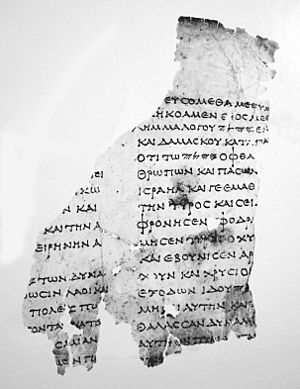Greek Minor Prophets Scroll from Nahal Hever facts for kids
The Greek Minor Prophets Scroll from Nahal Hever (also called 8HevXII gr) is an ancient Greek manuscript. It contains parts of the Old Testament books known as the Minor Prophets. This scroll is a revised version of the Septuagint, which was an early Greek translation of the Hebrew Bible. Experts believe it was written around the 1st century CE. Today, you can find this important manuscript at the Rockefeller Museum in Jerusalem.
Contents
Discovery of the Ancient Scroll
Hidden in a Cave
Around the 1st century CE, a group of Jewish people were hiding from Roman soldiers. These people, including soldiers, women, and children, took shelter in the caves of Nahal Hever. They were part of a rebellion led by Bar Kokhba. Roman camps were set up outside the caves, trapping the refugees inside.
When they realized they couldn't escape, the people decided to burn many of their belongings. However, they carefully hid the Greek Minor Prophets Scroll and other important documents. They buried them between rocks in a hidden part of the cave. Archaeologists later found a layer of burnt material, showing that the last people in the cave had indeed burned their possessions.
Finding the Dead Sea Scrolls
Between 1946 and 1947, Bedouin people discovered the famous Dead Sea Scrolls. These scrolls were found in caves near the Dead Sea. The Bedouins sold their finds to researchers in East Jerusalem. At first, they said the scrolls came from a different area to make their ownership seem more legitimate. Because of this, it was hard for archaeologists to know exactly where each scroll came from.
Identifying the Scroll's Origin
From 1952 to 1954, the Rockefeller Museum bought many manuscripts from people who had found them secretly. Among these were pieces of a scroll containing parts of the Twelve Prophets book. These pieces were given a special name: Se2grXII.
In 1953, a scholar named Dominique Barthélemy published a short study about these Greek Minor Prophets fragments. He didn't know exactly where they had been found.
To find out more, the Hebrew University of Jerusalem sent two expeditions in 1960 and 1961. During the 1961 expedition, led by Yohanan Aharoni, fragments of the Greek scroll were found in Cave No. 8 at Nahal Hever. This cave is also known as the "Cave of Horror." It soon became clear that these new fragments were from the same scroll that had been bought ten years earlier. This helped researchers confirm that the scroll truly came from Nahal Hever.
Studying the Fragments
Another scholar, Baruch Lifshitz, studied the fragments found in the Cave of Horror. He published his findings in 1961 and 1962. Later, in 1963, Dominique Barthélemy published a more detailed study of the scroll.
By 1990, Emanuel Tov published a full edition of the Greek Minor Prophets Scroll from Nahal Hever. To make it easier for scholars to talk about the scroll, Emanuel Tov, Robert A. Kraft, and Peter J. Parsons suggested using the name 8HevXIIgr. This is the name commonly used today.
New Discoveries in 2021
In 2021, archaeologists announced that new fragments of this scroll had been found. These new pieces are now being studied to help put together even more of the ancient text.
About the Scroll
What Kind of Text Is It?
Experts agree that this scroll is an early updated version of the Septuagint. It was changed to be more like the original Hebrew text of the Bible. Scholars like Dominique Barthélemy and Eugene C. Ulrich have said that it's not a brand new translation. Instead, it's a careful revision of an existing Greek text. This means it kept many parts of the old Greek translation but made changes to match the Hebrew more closely.
Size and Contents
The scroll is partly preserved, meaning some pieces are missing. However, the lower parts of many columns are still there. One column, column 8, has parts of all four edges. This helps researchers figure out the original size.
Each column on the scroll had about 42 lines of text. In some parts, written by a different scribe, the letters are larger, so those columns only have about 33 lines. The columns were about 27 centimeters (about 10.6 inches) tall. The width of the columns varied, from about 7.5 to 9 centimeters (about 3 to 3.5 inches).
If the scroll originally contained all twelve Minor Prophets books, it would have been very long. It would have had between 80 and 94 columns, stretching about 9.6 to 10 meters (about 31 to 33 feet) long! This would make it longer than most other scrolls found in Qumran. So far, only parts of the books of Jonah, Micah, Nahum, Habakkuk, Zephaniah, and Zechariah have been identified.
Who Wrote It?
The scroll was written by two different scribes, or writers. You can tell because the letters look different in style and size in different parts of the scroll. It's not clear why two different people wrote it. Maybe one person started it and another finished it. Or perhaps new pieces of leather with writing were added for repairs.
The text is divided into larger and smaller sections. You can even see divisions that look like verses. These divisions often match how the Hebrew Bible is divided. To mark a new section, the scribes sometimes drew a horizontal line. Other times, a new line would start slightly to the left with a slightly larger first letter.
The Divine Name: Tetragrammaton
This scroll is very special because it shows how the divine name of God, known as the Tetragrammaton, was used in the 1st century. The Tetragrammaton is made up of four Hebrew letters (YHWH).
In many ancient Greek translations of the Old Testament, Jewish scribes did not change the Tetragrammaton into a Greek word like "Lord" (Kyrios). Instead, they kept the original Hebrew letters. This is different from later Christian manuscripts, which often used "Lord" or other shortened forms.
In the Greek Minor Prophets Scroll, the Tetragrammaton appears in its original paleo-Hebrew script (an old form of Hebrew writing). The scribe seems to have written these Hebrew letters directly into the Greek text. This happens in several places, including parts of Jonah, Micah, Habakkuk, Zephaniah, and Zechariah. For example, in Zechariah 3:1-2, 5, and 6, the scroll says "Angel of YHWH" instead of "Angel of the Lord."
In March 2021, archaeologists found another Dead Sea Scroll, this one in Hebrew, that also used the paleo-Hebrew script for the Tetragrammaton. This shows how important it was to preserve the divine name in its original form in these ancient texts.
See also
 In Spanish: Rollo griego de los Profetas Menores de Nahal Hever para niños
In Spanish: Rollo griego de los Profetas Menores de Nahal Hever para niños
- Kaige revision
|



